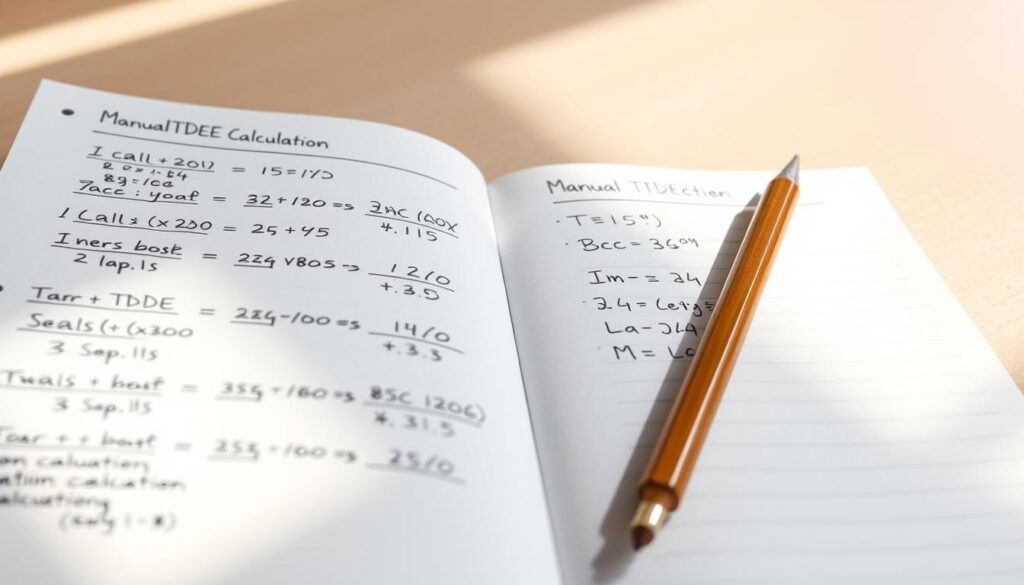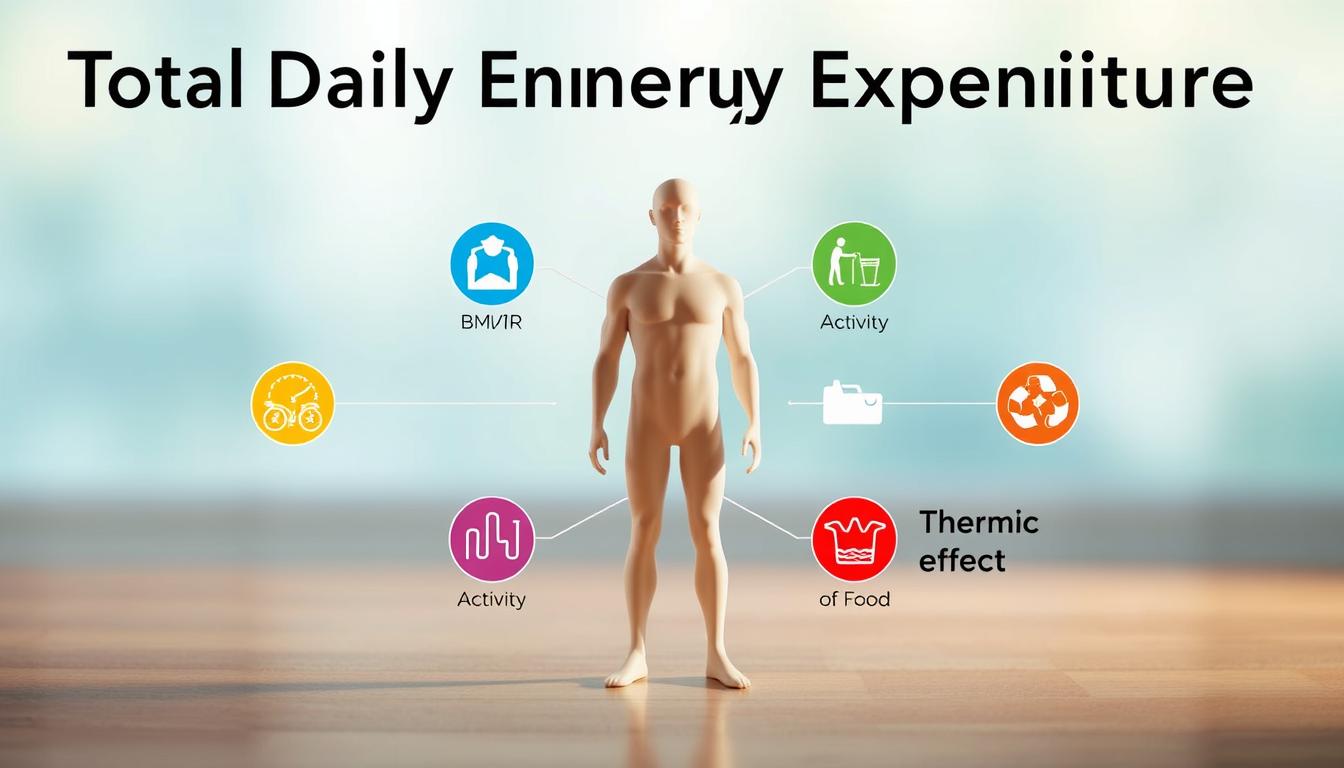What if you could master your body’s energy needs without relying on apps or tools? Most people assume tracking total daily energy requires complex math, but we’re here to simplify it. Let’s explore how understanding your body’s unique rhythm can unlock smarter health choices.
Your metabolic rate isn’t just a number—it’s the foundation of every calorie you burn. Whether you’re resting or active, your body constantly uses energy. By combining your baseline needs with daily movement, you’ll get a clear picture of your TDEE (Total Daily Energy Expenditure). This approach skips calculators and focuses on real-life patterns.
Why does this matter? Knowing your energy expenditure helps tailor nutrition and fitness goals. Forget generic formulas—we’ll break down a manual method that aligns with your lifestyle. No tech required, just practical insights.
Key Takeaways
- TDEE combines resting metabolism and activity-based calorie burn.
- Your metabolic rate determines baseline energy needs.
- Tracking total daily energy supports effective weight management.
- Manual calculations simplify understanding your body’s demands.
- Actionable steps replace dependency on digital tools.
Understanding TDEE and Its Role in Weight Management
Your body operates like a finely tuned engine, burning fuel even when idle. Total Daily Energy Expenditure represents every calorie your system uses—from breathing to brisk walks. Let’s unpack what this means for your health goals.
Defining Total Daily Energy Expenditure
Energy expenditure isn’t just gym time. It’s a blend of three elements:
- Basal functions: Calories burned maintaining heartbeat, digestion, and brain activity
- Daily movement: Energy used for chores, walking, or spontaneous fidgeting
- Exercise: Intentional workouts that spike calorie burn
Together, these create your unique daily energy profile. Think of it as your body’s hourly meter.
The Importance of Knowing Your TDEE
Why track energy expenditure? Imagine driving cross-country without a gas gauge. Body needs work similarly—ignoring them leads to guesswork in diet planning. Those who understand their total daily energy use:
- Avoid overeating or undereating pitfalls
- Align meals with actual calorie demands
- Adjust intake for weight loss/gain precision
For example, desk workers versus nurses have vastly different energy expenditure patterns. Recognizing this helps craft realistic nutrition strategies.
What Is Basal Metabolic Rate (BMR)?
Ever wondered why some people eat more without gaining weight? The answer lies in their basal metabolic rate—the calories burned while your body performs basic life-sustaining functions. Think of it as your internal furnace, working 24/7 to power breathing, circulation, and cell repair.
Explaining the Mifflin-St Jeor Equation
Scientists use formulas like the Mifflin-St Jeor Equation to estimate BMR accurately. This method considers four key factors:
- Weight: Heavier bodies require more energy
- Height: Taller individuals often have higher BMR
- Age: Metabolism slows by 1-2% per decade after 20
- Sex: Men typically burn more calories at rest
How BMR Affects Your Daily Calorie Needs
Your basal metabolic rate sets the floor for daily energy demands. For example, a 30-year-old woman with a BMR of 1,400 calories needs additional fuel for movement and digestion. This baseline helps tailor nutrition plans—whether maintaining weight or building muscle.
We’ll explore how BMR interacts with activity levels in later sections. For now, remember: understanding this number turns guesswork into strategy.
Differentiating TDEE, BMR, and Energy Expenditure
Imagine your body as a car dashboard with three fuel gauges. Each meter tracks distinct energy outputs: idle power, road trips, and spontaneous detours. This analogy helps clarify how BMR, TDEE, and general expenditure interact.
Basal Metabolic Rate (BMR) represents your engine’s idle mode. It’s the calories your body burns to sustain core functions like organ operation and temperature regulation. Even during sleep, this system hums steadily.
Total Daily Energy Expenditure (TDEE) adds movement to the equation. Think of it as combining idle fuel use with highway driving. It accounts for workouts, household chores, and even finger-tapping—every action beyond basic survival.
General energy expenditure acts as the odometer. It measures cumulative output over time, influenced by factors like genetics and meal frequency. Unlike BMR and TDEE, this broader concept includes external variables like climate and stress.
Here’s why distinctions matter:
- BMR forms 60-75% of daily calorie burn
- TDEE fluctuates with activity spikes
- Non-exercise movements often contribute 15-30% to total expenditure
Tailoring nutrition becomes precise when you separate these metrics. A marathon runner’s TDEE dwarfs their BMR, while a sedentary worker’s numbers align closely. Recognizing these layers turns guesswork into strategy.
The Science Behind the Mifflin-St Jeor Equation
Why do experts trust this formula more than older methods? The Mifflin-St Jeor Equation revolutionized BMR estimation by prioritizing real-world accuracy. Unlike outdated models, it accounts for modern lifestyles and body compositions.
How the Formula Works
This equation uses precise multipliers to translate physical traits into calorie needs. For every centimeter of height, it applies a 6.25 factor—recognizing taller frames require more energy. Age adjustments then account for metabolic slowdowns, while weight and sex complete the calculation.
Here’s what makes it reliable:
- 6.25 height multiplier: Reflects increased energy demands for vertical growth
- Age deduction: Subtracts 5 calories yearly after age 20
- Sex-specific constants: +5 for males, -161 for females
Proper nutrition amplifies these calculations. A diet rich in protein and fiber supports the metabolic rate predicted by your BMR. For example, someone with a 170cm height and active job needs more complex carbs than a sedentary peer.
Over 85% of dietitians use this formula, according to recent surveys. Its precision stems from studying thousands of adults across age groups and body types. By aligning food intake with these numbers, you turn biological data into actionable health plans.
Factors Influencing Your BMR and TDEE
Your body’s energy engine doesn’t run on autopilot. Multiple factors shape how efficiently you burn calories—some locked in your DNA, others shaped by daily choices. Let’s explore what pulls these metabolic levers.
Physical and Biological Factors
Muscle mass acts like a calorie-burning furnace. Those with higher lean tissue ratios torch more energy at rest compared to individuals carrying excess fat. This explains why two people of the same weight can have vastly different body needs.
Sex plays a role too. Men typically have 3-10% higher BMR than women due to greater muscle mass and bone density. Age—measured in years—gradually slows metabolism. After 30, most adults lose 3-8% of muscle mass per decade unless they actively preserve it.
Environmental and Hormonal Effects
Extreme temperatures force your body to work harder. Shivering in cold weather or sweating in heat waves can spike energy expenditure by 5-20%. Chronic stress triggers cortisol surges that may alter fat storage patterns and hunger signals.
Thyroid hormones act as metabolic conductors. An underactive gland can reduce BMR by 15-40%, while hyperthyroidism accelerates it. Even menstrual cycles create monthly fluctuations—some women burn 100-300 extra calories during ovulation phases.
Understanding these factors helps you work with your biology rather than against it. Adjusting protein intake during high-stress periods or scheduling workouts around hormonal shifts turns knowledge into practical advantage.
How to calculate TDEE without a calculator
Many struggle to balance food intake with their body’s actual needs. We’ll simplify this process using basic math and observational skills. First, start with your basal metabolic rate from earlier calculations.

Step-by-Step Estimation
- Multiply your BMR by an activity factor: 1.2 for sedentary, 1.5 for moderately active
- Add calories burned through exercise—20 minutes of brisk walking ≈ 100 calories
- Adjust for non-exercise movements like gardening or stair climbing
This gives your total energy needs per day. A teacher with light activity might use a 1.4 multiplier, while a construction worker could reach 1.8.
Practical Tips for Manual Calculation
Track movement patterns for three days without changing routines. Note time spent sitting versus active. Multiply your BMR by different activity factors each day, then average the results.
- Use simple rounding: 1,732 becomes 1,700 calories per day
- Account for weekend vs weekday activity differences
- Reassess monthly as routines change
To lose weight, create a 15-20% calorie deficit from your TDEE. For sustainable weight loss, reduce portions gradually rather than drastic cuts. Pair this with protein-rich meals to maintain muscle during fat loss.
Real-world example: Someone needing 2,200 calories per day for maintenance would aim for 1,760-1,870 for weight loss. This approach prevents metabolic slowdown while promoting steady progress.
Assessing Your Daily Activity Level
Movement patterns shape your energy needs more than you might realize. Physical Activity Levels (PAL) act as metabolic mirrors—they reflect how your daily habits influence calorie burn. This system uses multipliers to translate routines into energy demands.
Understanding Physical Activity Levels (PAL)
PAL categories simplify activity level assessment. Common classifications include:
- Lightly active: 1-3 weekly workouts + desk job (multiplier: 1.375)
- Moderately active: 4-5 exercise sessions + regular movement (multiplier: 1.55)
- Very active: Intense training 6-7 days + physical labor (multiplier: 1.725)
A nurse working 12-hour shifts might fall into the moderately active tier, while a marathon trainee could hit the highest level.
Selecting the Right Activity Factor
Honesty matters when choosing your multiplier. Track non-exercise movements for three days—steps taken, chores completed, or stairs climbed. These activity levels often reveal hidden calorie burns.
Small changes create big impacts. Adding two 15-minute walks daily could shift someone from lightly active to moderately active. This adjustment might increase total energy needs by 200-300 calories—equivalent to losing or gaining 2-3 pounds monthly.
Use these assessment tools:
- Smartphone step counters (aim for 7,000+ steps/day for moderate activity)
- Weekly movement journals
- Heart rate monitors during workouts
Simple Methods to Estimate Your Energy Expenditure
Estimating calorie burn is simpler when you decode your natural activity patterns. Your daily habits act as a living calculator, revealing energy needs through routine movements. We’ll show how to translate these actions into practical calories per day estimates—no equations required.
| Activity Level | Time Spent | Estimated Calories/Day |
|---|---|---|
| Sedentary | 8+ hours sitting | 1.2 x BMR |
| Light Activity | 4-7 hours moving | 1.4 x BMR |
| Active | 3+ hours exertion | 1.6 x BMR |
Your weight directly influences these numbers. A 160-pound person burns roughly 100 calories during 30 minutes of housecleaning. Double that for gardening or brisk walking. Track these efforts weekly to gauge your total daily burn.
Practical tip: Pair movement journals with basic multipliers. Note time spent standing, lifting, or climbing stairs. Multiply each hour by 50-150 calories based on intensity. This hands-on approach turns ordinary days into personalized metabolic maps.
Strategies to Boost Your BMR and TDEE Naturally
Many seek sustainable ways to enhance their body’s calorie-burning potential. By combining targeted exercise with smart nutrition, you can elevate both basal metabolic rate and total energy expenditure. These methods work synergistically, creating lasting metabolic changes without extreme measures.

Power Up With Resistance Training
Lifting weights builds lean muscle—a metabolic powerhouse. For every pound gained, your body burns 6-10 extra calories daily at rest. Compound movements like squats or push-ups engage multiple muscle groups, maximizing efficiency.
High-Intensity Interval Training (HIIT) sparks afterburn effects. A 20-minute cycling session can elevate calorie burn for 24+ hours post-workout. Alternate 30-second sprints with 1-minute recovery periods to ignite this metabolic boost.
Fuel Your Engine Smartly
Protein-rich meals require 20-30% more energy to digest than fats or carbs. Incorporate eggs, Greek yogurt, or lentils to leverage this thermic effect. Pair with fiber-rich vegetables for sustained energy release.
Stay hydrated—cold water temporarily increases calorie expenditure as your body warms it. Spices like cayenne pepper may also provide a slight metabolic lift through thermogenesis.
Practical integration tips:
- Schedule three weekly strength sessions
- Swap steady cardio for two HIIT workouts
- Consume 25-30g protein per meal
The Role of Nutrition and Exercise in Energy Balance
Fuel meets motion in a delicate dance that shapes your body’s energy equilibrium. Smart food choices and consistent activity levels act like synchronized partners—one replenishes energy stores, the other burns them efficiently. This synergy determines whether you maintain, lose, or gain weight.
Balancing Caloric Intake and Output
Your plate and workout routine should complement each other. Protein-rich meals sustain muscle repair after strength training, while complex carbs fuel endurance activities. For example:
- Pair grilled chicken with quinoa before weightlifting sessions
- Choose oatmeal and berries for sustained energy during long walks
- Hydrate with electrolyte-infused water during high-intensity workouts
Activity levels dictate nutritional needs. A construction worker requires more calorie-dense food than someone with a desk job. Track your movement patterns and adjust portions accordingly—active days demand higher fuel intake.
Three practical strategies:
- Time meals around exercise sessions (eat within 45 minutes post-workout)
- Match carb intake to activity intensity
- Increase protein consumption during strength training phases
Balance isn’t about perfection. A 200-calorie treat after cycling 10 miles maintains equilibrium. The key lies in aligning your food choices with your movement level—consistently and realistically.
Adjusting Calorie Intake for Weight Loss or Gain
Calorie adjustments act as metabolic steering wheels—turn them strategically to reach your body goals. Whether aiming to maintain weight, shed pounds, or build muscle, your energy intake needs precise calibration. Let’s map out sustainable strategies.
Start by setting clear targets. A 500-calorie daily deficit typically leads to 1-pound loss per week. For muscle gain, add 250-500 calories daily. These ranges prevent extreme swings while promoting steady progress.
“Small consistent changes outperform drastic restrictions. Your body adapts better to gradual shifts in fuel intake.”
| Goal | Daily Adjustment | Weekly Outcome |
|---|---|---|
| Weight Loss | -500 calories | -1 lb |
| Muscle Gain | +300 calories | +0.6 lb |
| Maintain Weight | ±100 calories | Stable |
Track changes using these methods:
- Weekly weigh-ins (same time/day)
- Clothing fit assessments
- Energy level journals
Those wanting to maintain weight often need the most precision. Hormonal shifts or activity changes can require 5-10% intake tweaks. A nurse working extra shifts might temporarily increase calories, while a vacationing office worker could reduce portions.
Rebound prevention matters. After achieving loss goals, slowly add 100-calorie increments weekly until stabilization. This helps your metabolism adjust without sudden shocks. Pair adjustments with protein-focused meals to preserve lean mass during transitions.
Common Pitfalls and Misconceptions
Even dedicated fitness enthusiasts often stumble when evaluating their true energy needs. Misjudging daily movement patterns creates ripple effects—overeating stalls progress, while undereating drains vitality. Recognizing these errors transforms guesswork into precision.
The Activity Estimation Trap
Many assume their gym session justifies a higher activity multiplier. Reality check: a 30-minute workout represents just 3% of your day. Non-exercise movements—like pacing during calls or gardening—often contribute more to total energy burn than formal training.
Common missteps include:
- Counting house chores as “light activity” when done sporadically
- Classifying desk jobs as “moderate” due to occasional walks
- Ignoring weekend sedentary habits when averaging weekly effort
| Misconception | Reality | Fix |
|---|---|---|
| “I walk 5,000 steps daily” | Moderate activity starts at 7,500+ steps | Use phone trackers for objective counts |
| “Yoga counts as cardio” | Most yoga burns 50% fewer calories than cycling | Pair with brisk walks |
Rebalance your approach with these strategies:
- Review activity logs weekly—adjust multipliers if patterns shift
- Compare estimated calorie burns with actual weight changes
- Reassess every 8-12 weeks as fitness levels evolve
Accuracy thrives on honesty. That “active rest day” might actually fall into the light activity tier. Periodic reality checks prevent metabolic math from veering off course.
Expert Advice and Additional Considerations
Navigating energy needs requires both self-awareness and expert insights. While manual calculations provide a solid foundation, certain situations demand specialized knowledge. Let’s explore when to trust your instincts—and when to seek qualified support.
Recognizing the Need for Guidance
Persistent fatigue despite adequate calorie intake often signals deeper issues. If your rest and recovery efforts don’t align with energy levels after 4-6 weeks, consult a healthcare professional. They can identify hormonal imbalances or nutrient deficiencies that skew metabolic math.
Unexplained weight fluctuations merit attention too. Gaining or losing 5% of body mass within a month without intentional changes could indicate thyroid disorders or metabolic adaptations. A registered dietitian helps decode these patterns through bloodwork and activity analysis.
| Sign | Possible Cause | Action Step |
|---|---|---|
| Chronic exhaustion | Iron deficiency | Blood test + nutrition plan |
| Plateaued progress | Metabolic adaptation | Adjust calorie cycling |
| Muscle loss | Protein underconsumption | Dietitian consultation |
Prioritize rest as part of your health strategy. Inadequate sleep reduces leptin (satiety hormone) by 18%, increasing hunger cues. Pair 7-9 hours of nightly sleep with active recovery days to maintain metabolic efficiency.
Seek a professional if self-guided adjustments fail. Certified trainers and nutritionists create personalized plans addressing your lifestyle, genetics, and goals. Their expertise turns stalled efforts into breakthroughs—safely and sustainably.
Conclusion
Mastering your body’s energy needs begins with awareness. We’ve explored how basal metabolic rate sets the foundation, while daily habits determine total calorie burn. These insights empower smarter choices—no apps or equations required.
Small adjustments create lasting change. Tracking movement patterns and aligning meals with actual needs helps maintain balance. Whether managing weight or optimizing fitness, understanding energy expenditure turns guesswork into strategy.
Revisit key concepts as your lifestyle evolves. Need help applying these principles? Our healthy weight gain diet plan calculator offers structured meal planning guidance. For persistent challenges, consult professionals to refine your approach.
Your health journey thrives on informed action. Start today—one intentional step reshapes tomorrow.


